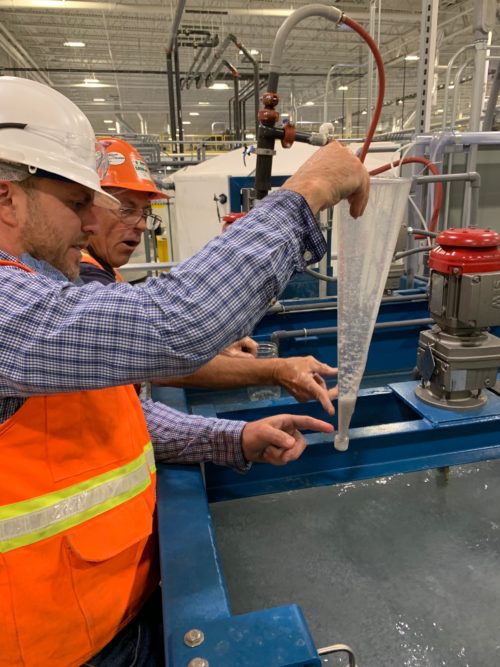We integrate a variety of technologies and techniques to effectively treat wastewater for discharge or reuse. The following are some of our primary offerings.
Water Softening, Demineralization, and Deionization Systems
At the forefront of Anguil’s offerings is our industrial water softening technology. Utilizing ion exchange (IX) resin, this process removes harsh ions like iron, calcium, manganese, and magnesium, substituting them with salt (brine). This not only softens the water but also ensures its suitability for industrial applications. The system is designed for periodic regeneration, maintaining its efficiency and longevity. For those needing further demineralization, Reverse Osmosis (RO) systems are another option.
Anguil can help with any size softening or demineralization system that you require for different needs such as boilers, bottling, or industrial processes.
Advanced Filtration Technologies
If your processed water or wastewater needs additional filtration of solids, Anguil’s expertise includes multiple filtration technologies. These technologies include microfiltration, ultrafiltration, nanofiltration, and reverse osmosis. Each of these play a crucial role in removing contaminants from processed water or wastewater, thus preventing equipment corrosion and inefficiency.
- Microfiltration: This process targets macromolecules such as algae, sediment, protozoa, and large bacteria, while leaving atomic or ionic materials, monovalent species, dissolved or natural organic matter, and small colloids and viruses. The wastewater goes through filters ranging from 0.1 to 10 μm, which can separate macromolecules of molecular weights less than 100,000 g/mol. It’s an effective pre-treatment step for other filtration processes and post-treatment for granular media filtration.
- Ultrafiltration (UF): UF operates on a similar principle but focuses on separating particles through a semipermeable membrane under pressure or concentration gradients. It’s excellent for purifying macromolecular solutions and is distinct from other filtration methods like membrane gas separation.
- Nanofiltration (NF): Employing even finer membranes, NF can filter particles smaller than 10 nanometers. Its membranes, made from materials like polyethylene terephthalate or metals such as aluminum, offer a unique filtration method, suitable for a range of industrial applications.
- Reverse Osmosis (RO): RO purifies water by applying a pressure stronger than the naturally occurring osmotic pressure to the contaminated side of the semi-permeable membrane, which pushes the purified solvent through and leaves the contaminated solute behind. This effectively removes dissolved or suspended chemical and biological substances. Its selective membranes are adept at allowing only smaller molecules like solvent molecules to pass through.
To help assist with ESG initiatives such as water reuse or near-Zero Liquid Discharge (nZLD), Anguil can test and find solutions with our filtration equipment.
Ion Exchange (IX) and Targeted Contaminant Removal Equipment
Ion Exchange (IX) softens and demineralizes water by replacing unwanted ions with those of the same charge. This process is particularly beneficial for targeting hard-to-remove contaminants in wastewater, often leading to significant cost savings in wastewater treatment and disposal.
Anguil has leveraged IX on hard to remove metals like molybdenum and as a post-treatment polishing step to meet stringent discharge requirements.
Oil Water Separators
Oil water separators (OWS) are crucial for separating oil (which can range from mineral, vegetable, animal, and different hydrocarbons) and water mixtures into separate components. These systems are designed and selected considering various performance parameters and life cycle costs, ensuring optimal separation efficiency.
There are numerous OWS technologies available, we have the necessary experience to ensure you select the proper features for your treatment needs.
Clarifiers
Clarifiers are employed for removing suspended solids (TSS) through gravity settling, causing the solids to create a sludge that sinks to the bottom.
Additional polishing of the effluent may be needed for discharge, and some companies may want to further treat the effluent to meet reuse standards to save money or meet ESG initiatives.
Selection of the type of clarifier is dependent on the wastewater make-up and your business criteria. We provide clients with a comparison of pros and cons to each clarification system as it relates to effluent targets.
Slant Plate Clarifier/Lamella
Slant Plate Clarifiers and Lamella Clarifiers are designed with a series of closely spaced flat plates inclined at an angle. This design facilitates the separation of entrained solids from preconditioned water as it flows through the plate pack. The system’s configuration, including plate spacing, angle, and path length, is meticulously tailored to each project’s requirements, ensuring optimal performance.
Dissolved Air Flotation (DAF)
The Dissolved Air Flotation system is a wastewater treatment that clarifies wastewater by removing suspended matter such as oils or solids. This process involves dissolving air in the wastewater under pressure and releasing it at atmospheric pressure in a flotation tank or basin, where the resulting tiny air bubbles adhere to the suspended matter, causing it to float to the surface and facilitating its removal.
- Floc Tubes: These are hydraulic flocculators that use the wastewater flow to mix the wastewater with chemicals, promoting coagulation and flocculation. This pretreatment step is often used to optimize the performance of Dissolved Air Flotation systems.
Ballasted Flocculation
This high-rate clarification system employs a physical-chemical treatment process using recycled media and various additives to improve the settling of suspended solids. The faster formation of the floc and decreased settling time allows clarification to occur up to 10 times faster than other processes. This, along with the smaller footprint, make this system ideal for a number of space constrained clients.
Advanced Biological Treatment Technologies
MBR, MBBR, FBR, and IFAS are widely used technologies in industrial wastewater treatment, especially for industrial applications with a high BOD loading such as food and beverages, dairy, chemical, leachate and wastewaters with high biological loadings. These treatment solutions can also handle high concentrations of Chemical Oxygen Demand (COD), oil & grease (FOG), volatiles, metals, ammonia, nitrate and inorganic.
- Membrane Bioreactor (MBR): Combining membrane processes like microfiltration or ultrafiltration with a biological treatment method (usually activated sludge), MBR is highly efficient for treating industrial wastewater containing organic and inorganic contaminants. MBR’s are more efficient and are often cost-effective when performance and tank requirements are considered.
- Anaerobic/Aerobic Digestion: These processes help break down organic waste. Anaerobic digestion happens when there is no oxygen in the procedure, forcing the bacteria to attack the organic material in the wastewater.
- Moving Bed Bio Reactor (MBBR): This system utilizes free-floating plastic media for biofilm growth to attach to. Continuous aeration or mixing must occur to ensure good sufficient contact between the organic matter and attached biofilm for efficient Biological Oxygen Demand (BOD) removal.
- Fixed Bed Bio Reactors (FBBR): Similar to MBBRs, with the main difference being that FBBRs use fixed media blocks for biofilm attachment. The fill media blocks are often arranged as submerged, retrievable cages within the basin, and include diffused aeration underneath the cage units supply the biofilm with the required oxygen.
- Integrated Fixed Film Activated Sludge (IFAS): Enhancing conventional activated sludge processes, IFAs uses plastic biomass carrier media (typically used in an MBBR process). IFAs typically increase treatment capacity of an existing activated sludge process without need to construct additional treatment tankage.
Oxidation and Ozone Treatment
- Oxidation: Utilizing oxidants like chlorine, ozone, and peroxide, this technology is effective in removing color, odor, and various contaminants and compounds from wastewater.
- Ozone: Ozonation destroys microorganisms and compounds using high pressures and flows. An ozone generator creates an electrical spark that splits O2 molecules to form two O- atoms, which then binds to other O2 molecules to create ozone (O3). The ozone will then oxidize and eliminate contaminants in the water, turning back into oxygen leaving no residuals.
Granular Activated Carbon (GAC) Systems
Anguil assists in optimizing GAC systems, a proven method to remove organic chemicals from water. This cost-effective solution might require additional treatment stages to meet specific discharge or beneficial reuse standards.
Solids Handling Equipment
Anguil offers a range of equipment for efficient and cost-effective solids handling, including:
- Filter Press
- Rotary Vacuum Drum
- Screw Press
- Belt Press
- Dryers
Anguil can help you align with a solids handling approach to meet your objectives. Whether you need a system that minimizes human intervention, reduces hauling costs, or increases water reuse, Anguil has the expertise and resources to ensure solids handling is not a concern.




